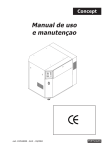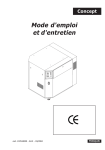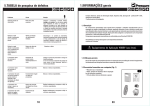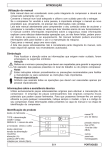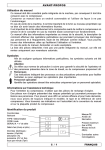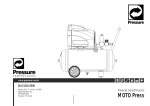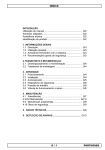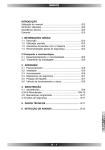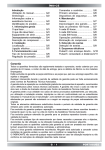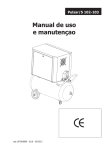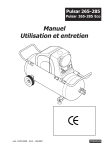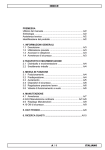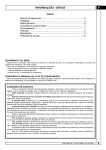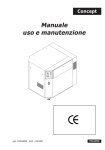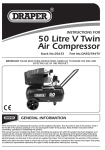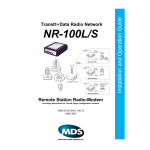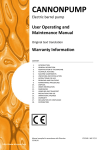Download 1 - Dari
Transcript
Concept Instruction and maintenance manual cod. 197634000 - Ed.5 - 03/2004 ENGLISH INDEX FOREWORD ........................................................................ 3 1.GENERAL INFORMATION ..................................................... 4 2. INSTALLATION ................................................................. 6 3. START-UP ....................................................................... 6 4. MAINTENANCE ................................................................. 8 5.TROUBLESHOOTING ........................................................ 10 6.WIRING DIAGRAMS ......................................................... 11 2 FOREWORD Use of the Instruction manual This manual is integral part of this compressor and should be kept for its whole working life. Keep this manual in a safe place so not to damage it. If the compressor is sold to a third party, also give the Instruction Manual to the new Owner. This manual should be carefully read before starting the compressor up and in case of any doubt on its operation. This manual contains important safety information on operation procedures, which should be complied with, otherwise injuries to people or damages to the machine might occur. Important use and maintenance instructions are also mentioned in this manual. Should this manual be lost, please ask for a new copy Spare parts list is not considered as integral part of this manual, since it is available at authorized dealers’ offices only. Symbols The following symbols are used for especially important information: Caution Highlights precautions to be taken to ensure safety of the operator, people in the compressor working area and the compressor. Notes Highlights recommended instructions or precautions to be taken to have an easier maintenance procedure or to explain most important instructions. Specialized personnel Every intervention highlighted by this symbol is exclusively the job of a specialized technician. Technical Assistance Use only genuine spare parts for servicing the compressor. Non-genuine spare parts might cause injuries to people. For efficient Technical Assistance, please always state model, type and part number of Your compressor. Those data are specified both on compressor plate and label on manual cover page. Product identification Manufacturer’s data TYPE = name CODE = compressor code SERIAL NO. = serial number 1 Air delivered (l/min) and (cfm) 4 Technical data: voltage (V/ph/Hz) absorption (A) power (HP and kW) rotations per minute (Rpm). 6 2 3 5 CE mark year of manufacture max. pressure (bar and PSI) noise level dB(A) 7 other approvals 3 1.GENERAL INFORMATION This compressor was designed and manufactured to be used only to deliver compressed air for handicraft and/or industrial applications in full compliance with the safety instructions provided in the following paragraphs. Compressor can be equipped with several accessories for blowing, washing and painting as well as air tools. See the relevant manuals for correct use of accessories and tools. Carefully read the User’s Manual before servicing the compressor. Before performing maintenance work, switch off the compressor and cut off power supply by switching off the wall-mounted switch (if any). What SHOULD BE DONE: • Understand how to stop the compressor at once and become familiar with the use of all controls.• Before any operation the compressor tank should be emptied. Unplug the compressor so to avoid any accidental compressor start. • After any maintenance operation make sure all the disassembled parts are properly assembled. • To have a safe operation, make all checks mentioned in chapter “Start-up” before starting the compressor. • Keep children and animals away from the working area, so as to avoid any injury caused by devices connected to the compressor. • Carefully read the instructions of any tool you have installed, especially if a spray gun is used, make sure the shop is well ventilated before you start painting. • Always start and stop three-phase compressor through the wall switch. • Should the compressor be working around the clock, the use of soundproof headset is recommended. What SHOULD NEVER BE DONE: • Do not paint indoor or close to naked flames. • Never touch cylinder head, cooling fins and delivery tube since they become very hot while working. They are still very hot for some time after stopping the compressor.• Never place inflammable nylon or cloth objects near or/and on the compressor. • Never move the compressor when the tank is under pressure. • Never use the compressor if the power cable is faulty or the connection is not safe. • Never aim the air jet either at people or animals.• Never allow anyone to operate the compressor without giving him/her proper instructions • Never hit flywheel and fans with metal or blunt objects. Compressor might break or be seriously damaged. • Never operate the compressor without an air filter. • Never tamper with the safety valve or the tank. • Never use the compressor in potentially explosive premises. • Never connect the air outlet cock to a tube with a max. capacity which is lower than the compressor capacity. Never run the compressor when temperature is under 0°C (operating temperature range: +5°C / +45°C). Apart from model Concept 870/7,5 V230/50 (operating temperature range: +5°C / +40°C) 4 1.GENERAL INFORMATION Standard accessories 1 Your compressor is delivered with the following accessories (fig.1): • User’s manual • Vibration-dampers + key to open panels • Elbow + line cock + Teflon tape • Connection hose. Unpacking and Handling (fig.2) • The compressor is usually shipped to the customer with a carton cover. Wear protective gloves and cut outer straps. Remove then package by lifting it from the top. 2 • Before removing the compressor, make sure it is intact (outside), open access doors (if any) and visually check components for damage. Check that all accessories are included. • Lift machine with a transpallet or fork lift truck, fit the vibration-damping pads in their housings and transport the machine with the utmost care to the place of installation. Connect the elbow as shown, and then connect the connection hose and the line cock supplied. • You are advised to keep the packing material in the event you need to re-locate the compressor. Keep package at least for the duration of the warranty period, so the compressor can be safely shipped to a service centre, if needed. When no longer needed, deliver packing material to the special collection centres for disposal. Compressor description Compressor main components are (fig.3): 1. Bare pump 2. Air radiator 3. Oil control (apart from SE models) 4. Check valve 5. Electric motor 6. Pressure switch (positioned outside on SE models) 7. Control panel (apart from SE models) 8.Electric equipment (apart from SE models) 3 6 1 2 3 7 4 5 5 8 2. INSTALLATION Placement Upon installation, make sure that the chosen place is in compliance with all prevailing national safety standards and meets the following requirements: • low percentage of dust suspended in air, • shop must be suitably sized and well ventilated so that room temperature never exceeds 40°C when the compressor is working. If this is not the case, install one or more exhaust fans to extract hot air. Ideally, the fans should be installed close to the ceiling. Power connection The compressor undergoes functional testing at the factory and is delivered ready for use. • Power connection is a critical phase of installation. Before making any operation, make sure that mains voltage is the same as the voltage rating specified in the CE plate and that switch is set to (0) (fig.4). • Have a wall-mounted switch provided with plug fuses 4 (rating must be at least equal to the values indicated in the I relevant table) installed upstream of the control panel by a 0 skilled technician. Switch should be installed within the operator’s reach. See wiring diagrams on chapter 6. In the event the machine needs to be modified for compliance with the rules in force in the User’s country or for any other requirements, have the job performed by skilled personnel only. Power Absorption Absorption HP V 230 A V 400 A 4 5,5 12,5 16,6 7,2 9,6 7,5 22 12,7 3. START-UP Type of operation START-STOP working : compressor starting is controlled by a pressure switch (5 seconds are needed for models with automatic starter). The compressor will stop when max. pressure is reached and it will automatically restart only when pressure is at the minimum allowed value. Working pressure adjustment • At User’s discretion, a pressure reducer can be installed downstream of the compressor. Have the distribution line configured by a qualified technician. • Always look up the ideal operating pressure of the tool you wish to use in the relevant manual. • After use, set pressure to 0 in order to prevent early wear of pressure reducer. 6 3. START-UP Controls and check devices The control panel (apart from SE models) includes the following controls and check devices (fig. 5): 1. On/Off Switch (I/0) 2. Oil level light 3. Emergency stop button (to be used only in an emergency) 4. Working hour counter 5. Air pressure gauge at delivery end 3 4 I 0 5 1 2 5 Once machine has been placed and connected to mains, it is ready for operation. It is recommended this operation - operational test - be performed by a specialized technician. Before continuing, make sure that · mains voltage is the same as voltage mentioned in the CE plate MAX MAX · all connections have suitable cross-section cable and that cables are neither damaged nor have bare wires; MIN MIN · wall-mounted switch is equipped with suitable fuses MAX · oil level is above the minimum (fig. 6) 6 · machine has been connected to tank. MIN After checking the above, proceed as follows: · Power the wall switch on 7 · Start the compressor powering the switch. · Check that the direction of rotation is the same as indicated by the arrow (fig.7). If the compressor is running in the wrong direction of rotation, power the machine immediately off. Power the main switch off and reverse two phases at terminals L1-L2-L3 of the switch. Restart the machine after powering the voltage on.Allow the motor to run for at least 5 minutes with the air cock open. Close the air cock and check that compressor is loading tank and that it duly stops once pressure gauge 5 detects that max. pressure has been reached. Now you may appreciate the easiness of use of your compressor. The pressure switch, which stops the motor when the max. pressure allowed is achieved, makes the compressor start again when pressure goes below the minimum threshold (about 2 bar less than the max. pressure). To stop the compressor, always use switch 1. That way, compressed air is drained from inside the head and re-starting is facilitated. Press the emergency stop button 3 in emergency cases ONLY. First start-up Safety devices • Operating pressure switch (see fig.3/4): determines STOP and START pressures. • Oil level control (fig. 6) - Apart from SE models 1) Oil level is checked every 5 seconds during compressor standard operating mode. If the feeler detects a low oil level for 12 times in a row, the compressor is stopped and the warning light (fig. 5 – ref. 2) turns on (steady light). What to do: power off and check the oil level, top up if necessary. Allow some minutes and 7 4. MAINTENANCE then restart the compressor. Should the machine stop once again, call an authorized service center. 2) If the light (fig. 5 – ref. 2) flashes after starting up the compressor or during compressor standard operation, the following might have happened: feeler short-circuited or contact open. Call an authorized service center in any case, as the feeler needs to be replaced. Should the above happen, the compressor can work for 3 hours more. Then it should be powered off and on again to continue working until the feeler is replaced. ALWAYS CHECK OIL LEVEL BEFORE RESTARTING THE COMPRESSOR. Before carrying out any maintenance operation: Switch off the machine and the wall-mounted switch. Bleed air from inside compressor and/or tank. Close the air cock between compressor and tank Cabinet panels disassembly Front and upper panels have to be removed to access the compressor (fig. 3). Front panel: use the key supplied with the machine to open the locks and remove panel by first pulling it upwards and then outwards Upper panel: unscrew the 4 screws with a 5-mm socket wrench and lift the panel. Never operate the compressor with the protection panels removed. 8 oil After the first 100 operating hours • Check that all screws are tightened, with special attention to head screws. • Check that all tubing connectors are tightened. • Check that the terminals of all wires brought to the control panel are tightened. • Check for any dust inside the cabinet to determine whether the conditions in the shop meet recommended requirements. If so, the compressor should be cleaned. • Change oil in the tank. Use one of the recommended safety oils (see following par.). EVERY 50 HOURS: oil level check and top-up Remove front panel and check oil level. If the level is below MAX., top up through filler plug (see fig.8 - following page). EVERY 300 HOURS: suction filter cleaning Remove the suction filter and clean or change the filter element as required. Clean the filter element as follows (fig. 9): wash in a solution containing normal detergent, rinse and dry completely before refitting. 8 9 4. MAINTENANCE Do not operate the compressor without the suction filter fitted, as foreign bodies or dust could seriously damage the inside components. NOTE: REPLACE FILTERING CARTRIDGE EVERY TWO OIL CHANGES. EVERY 300 HOURS: oil change • Remove front panel and undo the filler plug. Drain the oil through the drain hose and collect in a container. Close the drain plug and fill new oil (see fig. 8). Top up and change oil when the compressor is hot. Never mix different oils. Poor-quality oils may provide inadequate lubricating performance. Select oil type from the relevant table. Recommended oils SHELL Rimula D Extra 15W-40 AGIP Dicrea 100 BP Energol CS100 ESSO Exxc Olub H150 MOBIL Rarus 427 FUCHX Renolin 104L VG100 API CM-8X CASTROL Aircol PD100 IP Calatia Oil ISO 100 TOTAL Dacnis P100 EVERY 500 HOURS: drive belt tension check • Remove upper and rear panels. To check belt tension, apply a 30N/3 kg weight (fig. 10) at belt mid-length. Belt flexion should be about 10 mm. Loosen electric motor nuts. Tension up belt at motor end, taking care to preserve alignment with compressor pulley. Re-tighten the nuts. 10 3 Kg. 10 mm Routine maintenance • Every 6 months Clean air radiator and all radiator fins to preserve cooling efficiency and ensure greater machine performance. • Every 2 years 1) Check and clean suction and delivery valves. 2) Inspect check valve and change seal (A) (fig.11), if necessary. In these cases it is recommended to change relevant gaskets. 11 A Compressor disposal Dispose of all materials according to prevailing rules. Always contact special disposal and recycling centres. 9 5.TROUBLESHOOTING Problem Cause Remedy Air leaking off pressure switch valve when the compressor is stopped. Check valve leaking. Bleed air off the tank, remove the check valve cap and clean valve seat and sealing element. Replace the sealing element, if necessary. Air leaking off pressure switch valve for a long time when the compressor is running. Loadless start valve broken. Replace the valve. The compressor stops and cannot be restarted. Oil Control has triggered. Top up with oil and restart. Should the compressor stop once again, call a specialized technician. Winding burnt. Call a specialized technician. The compressor stops once Pressure switch defective or Call a specialized technician. max. pressure has been broken. reached and the safety valve starts working. The compressor does not charge and causes overheating. Heat gasket or valve broken. Stop the compressor with no delay and call a specialized technician. The compressor is too noisy and rattles. Bearings seizure. Stop the compressor with no delay and call a specialized technician. 6.WIRING DIAGRAMS SE Models (without electric equipment) PE L1 L2 L3 1) Electric motor 2) Pressure switch with oveload cutout 2A) Thermal relay P 2 2A 1 3 10 M 6.WIRING DIAGRAMS Models with direct starting P h TC ...................... FU1-FU2-FU3 .... KM1 ................... KM4 ................... FR ...................... SB1 ................... SB2 ................... SB3 ................... Y V ..................... KL ...................... SL ...................... HL1 .................... HL2 .................... PT ...................... Jumper .............. transformer Fuses 6.3x32 4A Line contactor 230V 50-60Hz Ancillary contactor 230V 50-60Hz Thermal relay Emergency stop button Luminous button + bulb carrier Reset button FR solenoid valve Oil control Oil level probe White indicator light Yellow indicator light Hour counter For remote control installation 11 Motor cable cross-section: 4 Hp compressors V230 ................. 4G2.5 sq mm V400 ................. 4G1.5 sq mm 5.5 HP compressors V230 ................. 4x4 sq mm V400 ................. 4G1.5 sq mm 7.5 HP compressors V230 ................. 4x6 sq mm V400 ................. 4G2.5 sq mm 6.WIRING DIAGRAMS Models with automatic starter TC ...................... FU1-FU2-FU3 .... KM1 ................... KM2 ................... KM3 ................... KM4 ................... KT ...................... FR ...................... SB1 ................... SB2 ................... SB3 ................... Y V ..................... KL ...................... SL ...................... HL1 .................... HL2 .................... PT ...................... Jumper .............. transformer Fuses 6,3x32 4A Line contactor 230V 50-60Hz Delta contactor 230V 50-60Hz Star contactor230V 50-60Hz Ancillary contactor 230V 50-60Hz Timer Thermal relay Emergency stop button Luminous button + bulb carrier Reset button FR solenoid valve Oil control Oil level probe White indicator light Yellow indicator light Hour counter For remote control installation 12 Motor cable cross-section: 5.5 HP compressors V230 ................. 7G2.5 sq mm V400 ................. 7G1.5 sq mm 7.5 HP compressors V230 ................. 7G2.5 sq mm V400 ................. 7G2.5 sq mm












